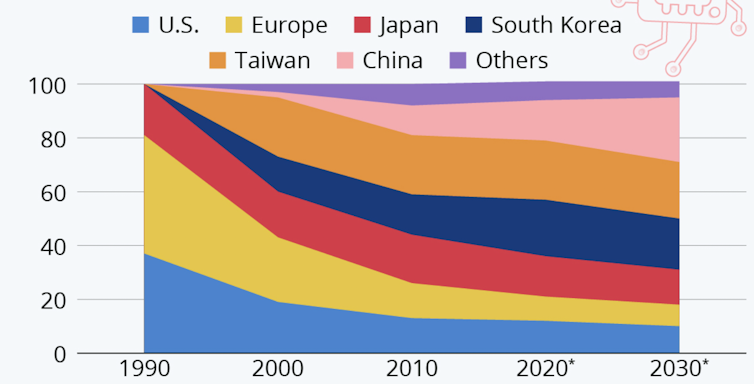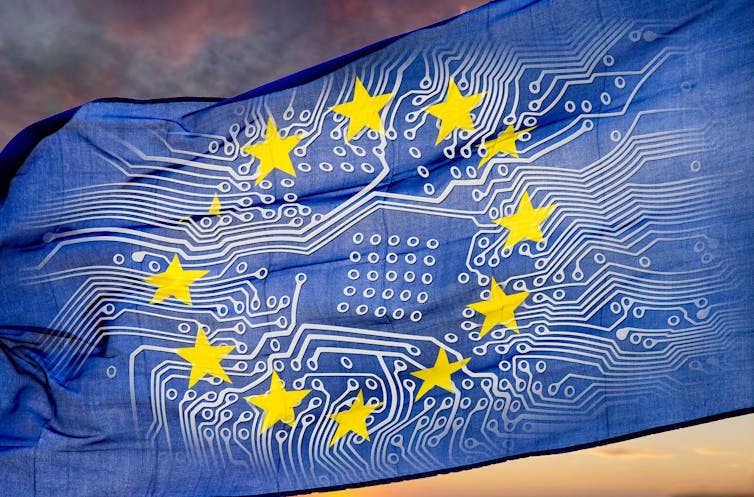Are There Any State of the Art European Semiconductor Manufacturers
Intel'south proposed US$30 billion (£23 billion) investment in semiconductor manufacturing chapters across Europe has the potential to significantly boost the continent's struggling chip manufacture.
The U.s. giant is poised to invest an initial US$17 billion to build a cutting-edge semiconductor mill (known every bit a fab) in Deutschland, along with associated R&D facilities to develop new generations of chips in French republic, Ireland and Poland. Information technology is also in negotiations with the Italian government to develop a manufacturing facility in that country.
If such proposals come to fruition, the overall investment could pinnacle US$80 billion and create over 3,000 high-tech jobs and many more than across the digital supply chain. Intel, the relevant national governments and the European Commission argue that these investments will transform Europe'southward semiconductor supply chain and make it more competitive. The function of national governments and the European Committee is important to note as Intel's investment is likely to be underpinned by billions of euros worth of public subsidies.
Flake production has been high on Europe'south agenda as many high-engineering science companies have been struggling to source fries because the COVID-19 pandemic has disrupted worldwide supplies. Europe's automotive manufacture has been peculiarly hindered as a result. Russia'south invasion of Ukraine has accentuated the trouble because the industry relies on both nations for neon, which is vital for the lasers used to cut land-of-the-art chips.
Intel'southward investment in new capacity is not going to address these current issues, given that product is not expected to brainstorm until 2027. Merely it could eventually ease Europe'south dependency on sourcing chips from afar and revitalise the continent's increasingly uncompetitive operations.
The earth market place
The semiconductor industry is global in telescopic, with nigh two-thirds of chips manufactured in Asia – particularly Republic of korea, Taiwan, Japan and Prc. This authority has come up at the expense of European producers, which now account for only around 8% of the world market, compared to 44% in 1990. This is largely the outcome of nether-investment.
Principally as a result of heightened geopolitical instability, the Eu has recently become concerned near "digital sovereignty". Its contempo European Fries Human activity set out a range of measures to boost European product by pooling unlike countries' resources to complement their individual enquiry strengths. Information technology likewise supports developing new production facilities with a view to increment Europe's share of the global market to 20% by 2030.

Intel's appear investment is the almost tangible outcome to appointment and is certainly welcome, though it is unlikely to fully rekindle the European industry alone. The manufacture tends to be populated by SMEs (smaller businesses) and clustered in a small number of locations, including Leuven (Belgium), Dresden (Frg), Eindhoven (Netherlands), Grenoble (France) and Cardiff (Britain).
Our recent research into these clusters suggests that many companies have been starved of investment from either private or public sources to expand and innovate. This is compounded by a lack of demand from European applied science companies.
For instance, with the demise of Nokia, Europe no longer has a giant company such equally Apple tree or Samsung that demands the most sophisticated chips. For many of Europe's semiconductor companies, which are engaged in chip design rather than product, these issues are stifling the growth of the industry more than a lack of manufacturing capacity.
What needs to happen
To accost this, the Intel intervention needs to course role of a coherent and integrated strategy to heave the competitiveness and innovation chapters of the European sector as a whole. Like other deep tech sectors, the fleck industry is increasingly an entrepreneurial ane. New and innovative ideas are sparked by start-up companies that are able to commercialise these ideas and create value.
There is a very real need to provide business and infrastructure support, too equally skills evolution and commercialisation routes to let start-ups to enter the manufacture and current incumbents to upgrade and scale up.

Innovation is conspicuously the name of the game when it comes to competitiveness in scrap-making. To give the European Committee its due, it has provided significant funding for semiconductor research over a number of years through the Framework and Horizon programmes. However, successful commercialisable innovations stemming from this enquiry accept been relatively sparse.
Therefore, alongside supporting large, foreign direct investment projects there must be an enhanced focus on improving the entrepreneurial and innovative capabilities and capacity beyond Europe's semiconductor industry. Without this, there is a real danger that due to a lack of meaning feasible demand in future, we will be reading news of the mothballing of the proposed new manufacturing facilities.
sulmanruspinfirl71.blogspot.com
Source: https://theconversation.com/will-intel-save-europes-struggling-semiconductor-industry-180517
0 Response to "Are There Any State of the Art European Semiconductor Manufacturers"
Post a Comment